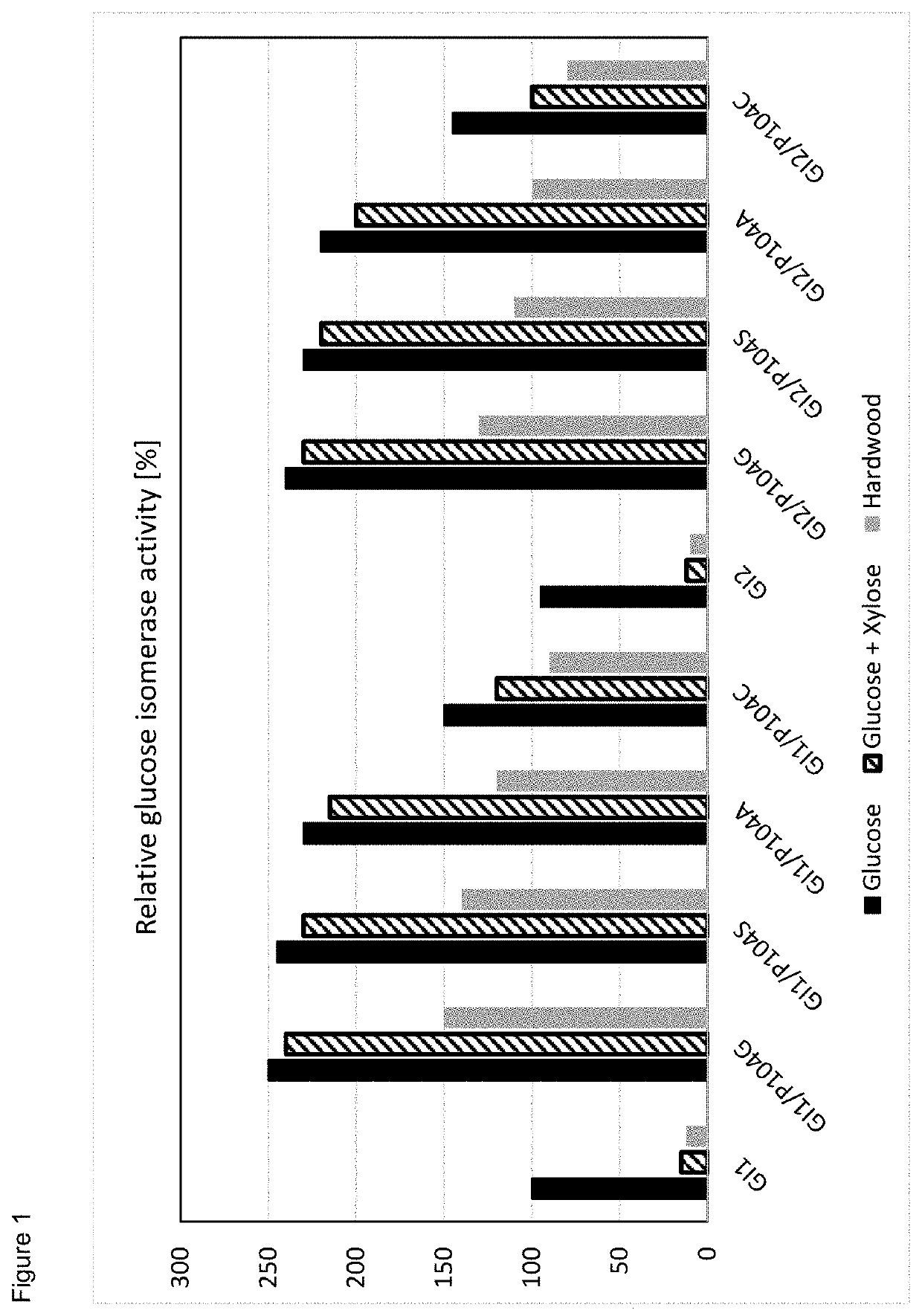New improved glucose isomerases
a glucose isomerase and glucose technology, applied in the field of enzymology, can solve the problems of significant cost of feed stock purification, significant decrease in the stability of the enzyme, and hampered use of the currently available glucose isomerase in the conversion of lignocellulose-derived glucose into fructose, etc., and achieve the effect of increasing or improving the activity of glucose isomeras
- Summary
- Abstract
- Description
- Claims
- Application Information
AI Technical Summary
Benefits of technology
Problems solved by technology
Method used
Image
Examples
example 1
on of Polypeptides According to SEQ ID NO: 1-10 and Nucleotides According to SEQ ID NO: 11-20
[0065]The DNA constructs according to SEQ ID NO: 11 and SEQ ID NO: 12 encoding the polypeptides according to SEQ ID NO: 1, SEQ ID NO: 2 were designed using codon frequencies optimized for expression in E. coli and commercially synthesized and cloned into a plasmid vector based on a standard pET28a+ plasmid. The plasmid vector contained an N-terminal nucleotide sequence encoding peptidyl-prolyl isomerase from Enterobacteriaceae (Protein databank accession number WP_000255997.1). The recombinant gene was expressed in Escherichia coli BL21(DE3) under the control of the T7-RNA-polymerase promoter (see Example 2). This resulted in expression of the recombinant proteins with an N-terminal tag. Nucleotide sequences according to SEQ ID NO: 13-20 encoding the glucose isomerases according to SEQ ID NO: 3-10 were ordered commercially and expressed in the same way as described herein.
example 2
ous Expression of Polypeptides with Glucose Isomerase Activity
[0066]Protein production was carried out in E. coli BL21(DE3) strain according to the plasmid manufacturer protocol available at http: / / richsingiser.com / 4402 / Novagen%20pET%020system% / 20manual.pdf. The incubation temperature for protein production was 30 degrees Celsius, which was found optimal for maximum yield of the active protein. Cells were lysed using lysis buffer (50 mM Tris-HCl pH7.4, 1% Triton X100, 1 mM CoCl2) and heated at 70 degrees Celsius for 30 min. The glucose isomerase activity was detected in the insoluble fraction only, and could be fully recovered by centrifugation. Thus, thermostable recombinant glucose isomerase was expressed in active insoluble form allowing reuse of the enzyme in several reaction batches. Mutations at position corresponding to position 104 of GI1 or GI-2 did not detectably effect the expression level of the recombinant proteins, they were essentially the same as the expression level...
example 3
somerase Activity Assay
[0067]Glucose isomerase activity (isomerization reaction rate) was determined by measuring fructose level in the reaction mixture according to the protocol described in Schenk and Bisswanger, A microplate assay for D-xylose / D-glucose isomerase. Enzyme and Microbial Technology (Elsevier Science Inc, N Y, 1998), V22, pp. 721-723.
[0068]Measurement was performed in the linear stage of the reaction course (product accumulation is linear with time). Ten-microliter aliquots of the reaction mixture were taken and pipette into a 96-well plate, 40 ul of water was added resulting in 50 ul sample. In some cases, higher dilution of the reaction mixture with water was used to prepare 50 ul of the diluted sample to match the dynamic range of the method. 150 ml of a freshly prepared 1:1 mixture (v / v) of solution A (0.05% resorcinol in ethanol) and solution B (0.216 g FeNH4(SO4)2*12 H2O in 1 l concentrated HCl) were added. For color development, the plate was incubated at 80° ...
PUM
| Property | Measurement | Unit |
|---|---|---|
| Fraction | aaaaa | aaaaa |
| Fraction | aaaaa | aaaaa |
| Fraction | aaaaa | aaaaa |
Abstract
Description
Claims
Application Information
 Login to View More
Login to View More - R&D
- Intellectual Property
- Life Sciences
- Materials
- Tech Scout
- Unparalleled Data Quality
- Higher Quality Content
- 60% Fewer Hallucinations
Browse by: Latest US Patents, China's latest patents, Technical Efficacy Thesaurus, Application Domain, Technology Topic, Popular Technical Reports.
© 2025 PatSnap. All rights reserved.Legal|Privacy policy|Modern Slavery Act Transparency Statement|Sitemap|About US| Contact US: help@patsnap.com

